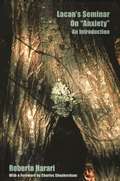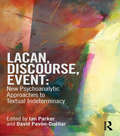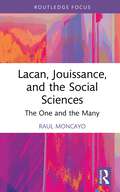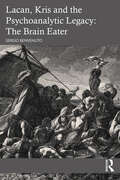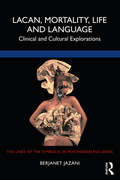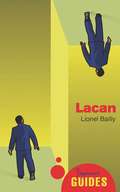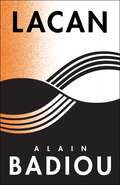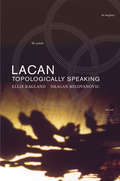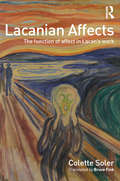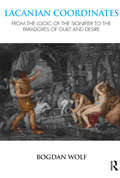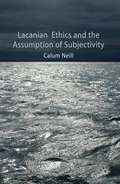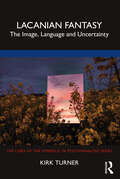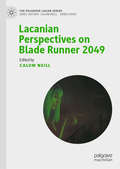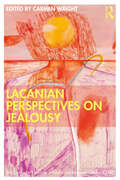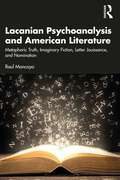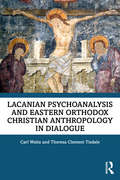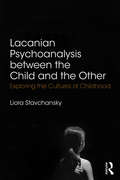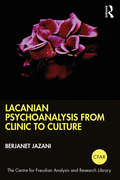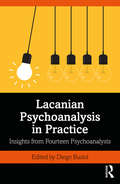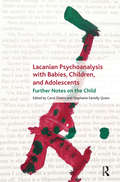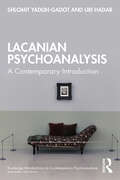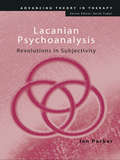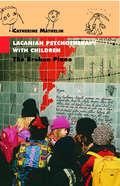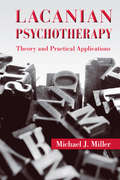- Table View
- List View
Lacan's Seminar on Anxiety: An Introduction (Lacanian Clinical Field)
by Roberto Harari Charles ShepherdsonDesigned for novices as well as students of psychology and literary criticism, these systematic lectures do much to clarify Lacan's groundbreaking work on the birth of the subject and its links with Freud's theory of drives. Moreover, they answer some of the criticisms that have been leveled at Lacan by forms of psychoanalysis unable or unwilling to incorporate his ideas.
Lacan, Discourse, Event: New Psychoanalytic Approaches To Textual Indeterminacy
by Ian Parker David Pavón-CuéllarLacan, Discourse, Event: New Psychoanalytic Approaches to Textual Indeterminacy is an introduction to the emerging field of Lacanian Discourse Analysis. It includes key papers that lay the foundations for this research, and worked examples from analysts working with a range of different texts. The editors Ian Parker and David Pavón-Cuéllar begin with an introduction which reviews the key themes in discourse analysis and the problems faced by researchers in that field of work including an overview of the development of discourse analysis in different disciplines (psychology, sociology, cultural studies and political and social theory). They also set out the conceptual and methodological principles of Lacan's work insofar as it applies to the field of discourse. Ian Parker and David Pavón-Cuéllar have divided the book into three main sections. The first section comprises previously published papers, some not yet available in English, which set out the foundations for 'Lacanian Discourse Analysis'. The chapters establish the first lines of research, and illustrate how Lacanian psychoanalysis is transformed into a distinctive approach to interpreting text when it is taken out of the clinical domain. The second and third parts of the book comprise commissioned papers in which leading researchers from across the social sciences, from the English-speaking world and from continental Europe and Latin America, show how Lacanian Discourse Analysis works in practice. Lacan, Discourse, Event: New Psychoanalytic Approaches to Textual Indeterminacy is intended to be a definitive volume bringing together writing from the leaders in the field of Lacanian Discourse Analysis working in the English-speaking world and in countries where Lacanian psychoanalysis is part of mainstream clinical practice and social theory. It will be of particular interest to psychoanalysts of different traditions, to post-graduate and undergraduate researchers in psycho-social studies, cultural studies, sociology and social anthropology.
Lacan, Jouissance, and the Social Sciences: The One and the Many (Routledge Focus on Mental Health)
by Raul MoncayoExploring how a Freudian-Lacanian approach to psychoanalysis intersects with social and cultural theory, Lacan, Jouissance, and the Social Sciences demonstrates the significance of subjectivity as a concept for the study of leadership, social psychology, culture, and political theory. Raul Moncayo examines Lacan’s notion of surplus jouissance in relation to four types of socio-economic value: Productive Value, Exchange Value, Surplus Value, and Profit. Also drawing on the work of Slavoj Žižek, Moncayo contends that surplus production cannot be reduced to alienated labor but rather includes various levels of jouissance-value. In this way, the jouissance that drives capitalization and organization can be theorized as constructive rather than destructive and encompass satisfaction and prosperity rather than individual suffering and asceticism or living with less. This volume will be of great interest to psychoanalysts both in practice and in training and to academics and scholars of psychoanalytic studies, Lacanian studies, and social sciences.
Lacan, Kris and the Psychoanalytic Legacy: The Brain Eater
by Sergio BenvenutoLacan, Kris and the Psychoanalytic Legacy: The Brain Eater examines the case of a scholar which was commented on by three leading psychoanalysts of the 20th century: Melitta Schmideberg, Ernst Kris, and Jacques Lacan. Sergio Benvenuto unpicks the complex case history of the patient he calls "Professor Brain", a man who struggled to publish his research because of his fixation on plagiarism, and who has never been identified. Benvenuto reconstructs the case through the first-hand accounts of the patient’s analysts and Lacan and sets it in the context of mid-century psychoanalytic debate. As we progress through the patient’s story, Benvenuto explains Lacan’s theories as they apply to the case: the "foreclosure" of orality; obsessional neurosis; mental anorexia; and, above all, the reasons for his opposition to Ego psychology, of which Kris was one of the most important representatives. This book will be of great interest to psychoanalysts in practice and in training, psychiatrists and clinical psychologists. It will also be of interest to academics and scholars of philosophy, the history of psychoanalysis, literature, and cultural studies.
Lacan, Mortality, Life and Language: Clinical and Cultural Explorations
by Berjanet JazaniThis work presents thoughts on the Lacanian subject: What are we as a speaking being? What makes us a human subject from a psychoanalytic perspective? Is it feelings and affect that make us a human? Or was it the Freudian invention of the unconscious that drew a line between human and a non-human? What can be learnt from the subject of the unconscious in the clinic of psychoanalysis that can help us to approach these questions? Berjanet Jazani takes examples from the psychoanalytic clinic as well as cultural references ranging from ancient Persia to London’s Theatreland in order to elaborate the question of subjectivity, reality and truth from a psychoanalytic perspective. In the era of hyperreality, the agency of branding and marketing strategies has overshadowed the reality of a human being, his true nature and agency. The hyperreality of contemporary society creates in each individual a false hope of becoming a high-fidelity copy of their idols, and such a fallacy has led many to believe that this is what determines their being in a social bond. Jazani explores the question of the reality and mortality of a subject through a Lacanian prism, from the theorising of analytical subjectivity that starts with the Freudian Oedipal myth more than a century ago to the futurist aspiration to fabricate human beings according to some ideal model. This book will be important reading for students and academics of Lacanian psychoanalysis, as well as professionals concerned with complex social problems.
Lacan, Psychoanalysis, and Comedy
by Patricia Gherovici Manya SteinkolerThis collection of essays explores laughter, humor, and the comic from a psychoanalytic perspective. Edited by two leading practicing psychoanalysts and with original contributions from Lacanian practitioners and scholars, this cutting-edge volume proposes a paradigm swerve, a Freudian slip on a banana peel. Psychoanalysis has long been associated with tragedy and there is a strong warrant to take up comedy as a more productive model for psychoanalytic practice and critique. Jokes and the comic have not received nearly as much consideration as they deserve given the fundamental role they play in our psychic lives and the way they unite the fields of aesthetics, literature, and psychoanalysis. Lacan, Psychoanalysis and Comedy addresses this lack and opens up the discussion.
Lacan: A Beginner's Guide (Beginner's Guides)
by Lionel BaillyJacques Lacan was one of the most important psychoanalysts ever to have lived. Building upon the work of Sigmund Freud, he sought to refine Freudian insights with the use of linguistics, arguing that "the structure of unconscious is like a language". Controversial throughout his lifetime both for adopting mathematical concepts in his psychoanalytic framework and for advocating therapy sessions of varying length, he is widely misunderstood and often unfairly dismissed as impenetrable. In this clear, wide-ranging primer, Lionel Bailly demonstrates how Lacan's ideas are still vitally relevant to contemporary issues of mental health treatment. Defending Lacan from his numerous detractors, past and present, Bailly guides the reader through Lacan's canon, from "l'objet petit a" to "The Mirror Stage" and beyond. Including coverage of developments in Lacanian psychoanalysis since his death, this is the perfect introduction to the great modern theorist.
Lacan: Anti-Philosophy 3 (The Seminars of Alain Badiou)
by Alain BadiouAlain Badiou is arguably the most significant philosopher in Europe today. Badiou’s seminars, given annually on major conceptual and historical topics, constitute an enormously important part of his work. They served as laboratories for his thought and public illuminations of his complex ideas yet remain little known. This book, the transcript of Badiou’s year-long seminar on the psychoanalytic theory of Jacques Lacan, is the first volume of his seminars to be published in English, opening up a new and vital aspect of his thinking.In a highly original and compelling account of Lacan’s theory and therapeutic practice, Badiou considers the challenge that Lacan poses to fundamental philosophical topics such as being, the subject, and truth. Badiou argues that Lacan is a singular figure of the “anti-philosopher,” a series of thinkers stretching back to Saint Paul and including Kierkegaard and Nietzsche, with Lacan as the last great anti-philosopher of modernity. The book offers a forceful reading of an enigmatic yet foundational thinker and sheds light on the crucial role that Lacan plays in Badiou’s own thought. This seminar, more accessible than some of Badiou’s more difficult works, will be profoundly valuable for the many readers across academic disciplines, art and literature, and political activism who find his thought essential.
Lacan: Topologically Speaking (Lacanian Clinical Field)
by Ellie RaglandThe study of topology examines the way something can change shape while still retaining the same properties. Jacques Lacan devoted the last part of his teaching to the topology of the subject. During the 50s, he gauged the topology of surfaces (torus, Moebius strips, Klein bottles, crosscaps) and from 1972 on, he studied the topology of knots (Borromean, the sinthome). Showing that bodily and mental life function topologically, he did what no one had done before: he added to the logic of how representations function, the logic of jouissance or libidinal meaning that "materializes" language by making desire, fantasy, and the partial drives ascertainable functions of it. For Lacan, topology is neither myth nor metaphor. It is the precise way we may understand the construction and appearance of the subject. Space is multidimensional in terms of both meaning and logic.Lacanian topology answers questions of post-structuralism while revealing the flaws in its theories. It also advances a 21st-century teaching that obviates symbolic logic and its positivistic assumptions. Applications are made to the clinic, to literature, and to the social sciences.The authors collected here include world renowned Lacanian topologists such as Jacques-Alain Miller, Jeanne Lafont, Jean-Paul Gilson, Pierre Skriabine, Juan-David Nasio, Jean-Michel Vappereau, and several new theorists from the United States and Europe.
Lacanian Affects: The function of affect in Lacan's work
by Colette SolerAffect is a high-stakes topic in psychoanalysis, but there has long been a misperception that Lacan neglected affect in his writings. We encounter affect at the beginning of any analysis in the form of subjective suffering that the patient hopes to alleviate. How can psychoanalysis alleviate such suffering when analytic practice itself gives rise to a wide range of affects in the patient’s relationship to the analyst? Lacanian Affects: The Function of Affect in Lacan’s Work, is the first book to explore Lacan’s theory of affect and its implications for contemporary psychoanalytic practice. In it, Colette Soler discusses affects as diverse as the pain of existence, hatred, ignorance, mourning, sadness, "joyful knowledge," boredom, moroseness, anger, shame, and enthusiasm. Soler’s discussion culminates in a highlighting of so-called enigmatic affects: anguish, love, and the satisfaction related to the end of an analysis. Lacanian Affects provides a unique and compelling account of affect that will prove to be an essential text for psychoanalysts, psychiatrists, psychotherapists, psychologists, and social workers.
Lacanian Coordinates: From the Logic of the Signifier to the Paradoxes of Guilt and Desire
by Bogdan WolfPsychoanalysis is an experience of truths and lies in language. It is also a discourse, and a praxis. Lacanian Coordinates takes the reader from the beginning of Lacan's teaching, from the logic of the signifier and the Lacanian subject, to the drive and object a, qua object a, the paradoxes of guilt, and finally to the desire of the Other, love, and femininity - the themes which are explored and developed in the forthcoming second volume of Lacanian Coordinates. This book explores the points of Lacanian orientation that lead us to the particularity of the subject, and considers whether we find them not solely in the discourse of the universal, to which religion, science and philosophy testify, but also in the analytic experience itself. Psychoanalysis creates conditions for an encounter with an analyst and with words forgotten, neglected, underestimated, yet also bursting with meaning and surprises. Each chapter contributes to this subjective realisation, taking as reference the clinic, the voice of an analysand, and everyday discourse.
Lacanian Ethics and the Assumption of Subjectivity
by Calum NeillHowever we conceive of ethics, whether by appeal to an exterior or traditional notion of right and wrong, or by appeal to some form of individual virtue or responsibility, it implies some form of agency. Where there is an ethical act, there must be someone acting ethically. Working from this simple premise, this book argues that the manner in which we conceive that 'someone' is the condition of possibility for our conception of ethics and, consequently, our ethical potential. Against the commonplace conception of the modern individual as self-identical, self-aware and self-governing, theauthor presents a detailed introduction to the Lacanian subject, a conception of the self as anything but self-identical, self-aware and self-governing. The book goes on to show how such a rethinking of the subject necessitates a rethinking of our relation to law, tradition and morality, as well as a rethinking of our understanding of guilt, responsibility and desire. In short, it necessitates a rethinking of ethics. "
Lacanian Fantasy: The Image, Language and Uncertainty
by Kirk TurnerLacanian Fantasy addresses the question of how fantasy developed as a psychological concept, particularly as influenced by Sigmund Freud and Jacques Lacan. Kirk Turner moves thematically, from childhood to adulthood, and chronologically, from Freud’s earliest theories to Lacan’s most complex statements on fantasy towards the end of his career. He explores not only the variations that the concept has undergone throughout its history – from Ancient Greek discourse around phantasia to the present day – but also the changing consequences of its applications. Lacanian Fantasy includes further insights on our current predicament: the age of the social media image and fantasy in the uncertain ‘locked down’ world of a pandemic. Spanning numerous examples, both historical and recent, this book explores relatable forms of fantasy life. In bridging psychology and philosophy, as well as gender and sexuality studies, it ultimately opens new perspectives on fantasy. This book will be of interest to psychoanalytic practitioners and humanities scholars, as well as students interested in critical theory.
Lacanian Perspectives on Blade Runner 2049 (The Palgrave Lacan Series)
by Calum NeillThis book provides a collection of Lacanian responses to Denis Villeneuve’s Blade Runner 2049 from leading theorists in the field. Like Ridley Scott’s original Blade Runner film, its sequel is now poised to provoke philosophical and psychoanalytic arguments, and to provide illustrations and inspiration for questions of being and the self, for belief and knowledge, the human and the post-human, amongst others. This volume forms the vanguard of responses from a Lacanian perspective, satisfying the hunger to extend the theoretical considerations of the first film in the various new directions the second film invites. Here, the contributors revisit the implications of the human-replicant relationship but move beyond this to consider issues of ideology, politics, and spectatorship. This exciting collection will appeal to an educated film going public, in addition to students and scholars of Lacanian psychoanalysis, psychoanalytic theory, cultural studies, film theory, philosophy and applied psychoanalysis.
Lacanian Perspectives on Jealousy (The Centre for Freudian Analysis and Research Library (CFAR))
by Carmen WrightA great effort has been made in contemporary Western culture to move beyond jealousy in our private lives - we have renegotiated old prohibitions, reorganising our sex lives, relationships, and family structures in new and inventive ways. But have we really been so successful at bearing the knowledge that, at a certain point, others’ desires belong only to them? This collection takes the temperature of jealousy today – how does it show up in the clinic? Does this differ from how it used to? What can be said of how jealousy functions both psychically and socially? Clinicians and writers working from within a Lacanian psychoanalytic framework explore the concept and unpack not only its numerous guises and forms, but its founding effects on the levels of both the individual and the social. The question as to where jealousy is located today leads to a deeper look at the feeling’s origins: its close relation to identification and with envy, its interaction with early infantile complexes, its constant interplay with the social realm and its systems of governance, and its complex expression of ambivalence towards the maternal.This book is for anyone interested in psychoanalysis, be they readers or historians of psychoanalysis, or clinicians looking for ways to approach jealousy in their practice. It is also for anyone who knows what it is to suffer jealousy, which if Freud was right, is most of us.
Lacanian Psychoanalysis and American Literature: Metaphoric Truth, Imaginary Fiction, Letter Jouissance, and Nomination
by Raul MoncayoLacanian Psychoanalysis and American Literature considers the psychoanalytic applications of three classic works of nineteenth-century literature, applying Lacanian concepts throughout. Moncayo imports the dynamisms and texture of three English and American stories with the aim of developing psychoanalytic theory, rather than simply confirming or applying previously adopted psychoanalytic concepts and theory. The author begins with The Purloined Letter by Edgar Allan Poe, assessing the differences between Derrida and Lacan’s analysis of this famous story. The book then considers The Turn of the Screw by Henry James, using James’ text for an in-depth analysis of Lacan’s Seminar on the Logic of the Fantasy, and Wuthering Heights by Emily Brontë, considering "passage à l'acte," and the objet a as the Wind and Heart of the Signifier. The authors use Lacan’s later theories to cast a new interpretative light on the stories, much as Lacan himself did with the work of James Joyce. Lacanian Psychoanalysis and American Literature will be of interest to academics and scholars of literary studies, psychoanalytic and Lacanian studies and Philosophy.
Lacanian Psychoanalysis and Eastern Orthodox Christian Anthropology in Dialogue
by Carl Waitz Theresa TisdaleThis book vigorously engages Lacan with a spiritual tradition that has yet to be thoroughly addressed within psychoanalytic literature—the Eastern Orthodox Christian tradition. The book offers a unique engagement with a faith system that highlights and extends analytic thinking. For those in formation within the Orthodox tradition, this book brings psychoanalytic insights to bear on matters of faith that may at times seem opaque or difficult to understand. Ultimately, the authors seek to elicit in the reader the reflective and contemplative posture of Orthodoxy, as well as the listening ear of analysis, while considering the human subject. This work is relevant and important for those training in psychoanalysis and Orthodox theology or ministry, as well as for those interested in the intersection between psychoanalysis and religion.
Lacanian Psychoanalysis between the Child and the Other: Exploring the Cultures of Childhood
by Liora StavchanskyLacanian Psychoanalysis between the Child and the Other explores what topology can contribute to clinical work with children, emphasizing that psychoanalytic listening goes beyond the individuals who attend a session. This kind of listening does not seek for what is hidden inside; rather it seeks to create a continuous topological transformation, with topology regarded as the most sophisticated way in which structure, structuring and playing can be thought. Using Lacan’s theoretical framework, the book provides a new perspective on working with children, re-examining fundamental Lacanian concepts such as structure, subject, lack, Other, clinic and, of course, child itself. It charts how time and space are knitted together for children in psychoanalysis, and how a Lacanian approach can enable clinical practitioners and researchers to venture into cultures of childhood, helping them conceptualize and intervene in the process of knitting and unknotting. The book will be of interest to psychoanalytic child clinicians in practice and training, as well as researchers in the field of child psychoanalysis.
Lacanian Psychoanalysis from Clinic to Culture (The Centre for Freudian Analysis and Research Library (CFAR))
by Berjanet JazaniThis accessible and insightful book merges Lacanian theory, psychoanalytic case studies, and the author’s personal experiences to illuminate the relevance of Lacanian psychoanalysis in mapping contemporary subjectivity. Using examples from cinema, artificial intelligence, and clinical and cultural references, the book covers major topics within the field, including dreams, the mirror phase, psychosis, hysteria, the position of the analyst, the drive, supervision and the symptom. Each is set within the context of our technologically oriented, market-based society and complemented with empirical vignettes. The book’s final section examines contemporary society and radicalization. Lacanian Psychoanalysis from Clinic to Culture is important reading for students and academics in Lacanian psychoanalysis, as well as professionals concerned with complex social problems.
Lacanian Psychoanalysis in Practice: Insights from Fourteen Psychoanalysts
by Diego BusiolIn this book, fourteen Lacanian psychoanalysts from Italy and France present how they listen and understand clinical questions, and how they operate in session. More than a theoretical ‘introduction to Lacan’, this book stems from clinical issues, is written by practicing psychoanalysts and does not only present theoretical concepts, but their use in practice. Psychoanalytic listening is the leitmotif of this book. How, and what, does a psychoanalyst listen to/for? How to effectively listen, and thus understand, something from the unconscious? Further, this book examines the evolution of psychic symptoms since Freud’s Studies on Hysteria to today, and how the clinical work has changed. It introduces to the differences between 'classic' discourses and ‘modern’ symptoms, with also a spotlight on some transversal issues. Chapters include hysteria, obsessive discourse and phobia, paranoia, panic disorder, anorexia, bulimia, binge-eating and obesity, depressions, addictions, borderline cases, the relationship with the mother, perversion, clinic of the void, and jealousy. Despite possessing the same theoretical reference of Sigmund Freud and Jacques Lacan, the contributors of this book belong to different associations and groups, and each of them provides several examples taken from their own practice. Lacanian Psychoanalysis in Practice is of great interest to psychoanalysts, psychotherapists, students and academics from the international psychoanalytic community.
Lacanian Psychoanalysis with Babies, Children, and Adolescents: Further Notes on the Child
by Stephanie Farrelly QuinnLacan did not say or write very much about the psychoanalysis of children. There is no doctrine of the psychoanalysis of children in his work. Instead, his 1956-1957 seminar on 'the object relation' and his 'Note on the Child' of 1969 have been adopted by Lacanian analysts working with children as providing essential coordinates for direction in their clinical work. This book is the result of inviting psychoanalysts of the Lacanian orientation working with children around the globe to theorise and conceptualise that work. The Lacanian psychoanalyst works with the notion of the subject as a 'speaking being', but the child subject brings particular exigencies to the psychoanalytic work. Contributors attend to these exigencies in their essays by articulating the precise particularities of the direction of the treatment and psychoanalytic work with children.
Lacanian Psychoanalysis: A Contemporary Introduction (Routledge Introductions to Contemporary Psychoanalysis)
by Uri Hadar Shlomit Yadlin-GadotLacanian Psychoanalysis: A Contemporary Introduction sees Shlomit Yadlin-Gadot and Uri Hadar provide an original approach to the elaborate and complex world of Jacques Lacan, one of psychoanalysis’s most innovative thinkers. This succinct introductory volume offers a fresh exposition of Lacanian thought, marking the philosophic influences and sensibilities that shaped it and presenting its ideas and concepts in a simple language. Illustrations that range from the clinical and cultural to daily contemporary experience enliven the theory and make it easily accessible. The Lacanian psyche is thoroughly explained and described, unfolding as a drama of desire and jouissance, of hopes and disillusions. Its elusive subject is predicated upon otherness and decentred by its various forms: language and culture, meaningful people, and the body. From this perspective, the authors illustrate how Lacan showed that love, sex, politics, and therapy always involve the desire to be with the other but, at the same time, to be free of her. Part of the Routledge Introductions to Contemporary Psychoanalysis series, this book is a must-read for psychoanalysts, students and scholars familiar with Lacan’s ideas, as well as those approaching his theories for the first time. Lacan’s unique and revolutionary understanding of human experience will benefit any scholar of human subjectivity, including art critics, cultural theorists, political commentators and academics in the humanities and social sciences.
Lacanian Psychoanalysis: Revolutions in Subjectivity (Advancing Theory in Therapy)
by Ian ParkerJacques Lacan's impact upon the theory and practice of psychoanalysis worldwide cannot be underestimated. Lacanian Psychoanalysis looks at the current debates surrounding Lacanian practice and explores its place within historical, social and political contexts. The book argues that Lacan’s elaboration of psychoanalytic theory is grounded in clinical practice and needs to be defined in relation to the four main traditions: psychiatry, psychology, psychotherapy and spirituality. As such topics of discussion include: the intersection between psychoanalysis and social transformation a new way through deadlocks of current Lacanian debate a new approach to ‘clinical structures’ of neurosis, perversion and psychosis Lacanian Psychoanalysis draws on Lacan's work to shed light on issues relevant to current therapeutic practice and as such it will be of great interest to students, trainees and practitioners of psychoanalysis, psychotherapy, counselling and other domains of personal and social change.
Lacanian Psychotherapy With Children: The Broken Piano (Lacanian Clinical Field Ser.)
by Catherine MathelinIn a groundbreaking integration of the work of Lacan, Winnicott, and Tustin, Catherine Mathelin reveals how a child's symptoms can be a striking reflection of its parents' unresolved conflicts. She shows how her patients' art, much of it reproduced here, can communicate both initial anguish and progress in treatment, and draws on her experience of working on a neonatal unit to argue compellingly that a child's mental health can be endangered even before birth."This is a book hard to put down, filled with the most fascinating brief case vignettes of parents and children who live in worlds disconnected from each other, hoping for experts to heal their suffering." -Anni Bergman, coauthor of The Psychological Birth of the Human Infant
Lacanian Psychotherapy: Theory and Practical Applications
by Michael J. MillerThe work of Jacques Lacan is associated more with literature and philosophy than mainstream American psychology, due in large part to the dense language he employs in articulating his theory – including often at the expense of clinical illustration. As a result, his contributions are frequently fascinating, yet their utility in the therapeutic setting can be difficult to pinpoint. Lacanian Psychotherapy fills in this clinical gap by presenting theoretical discussions in clear, accessible language and applying them to several chapter-length case studies, thereby demonstrating their clinical relevance. The central concern of the book is the usefulness of Lacan's notion that the unconscious is structured like and by language. This concept implies a peculiar manner of listening ("to the letter") and intervention, which Miller applies to a number of common clinical concerns – including including case formulation, dreams, transference, and diagnosis – including all in the context of real-world psychotherapy.
